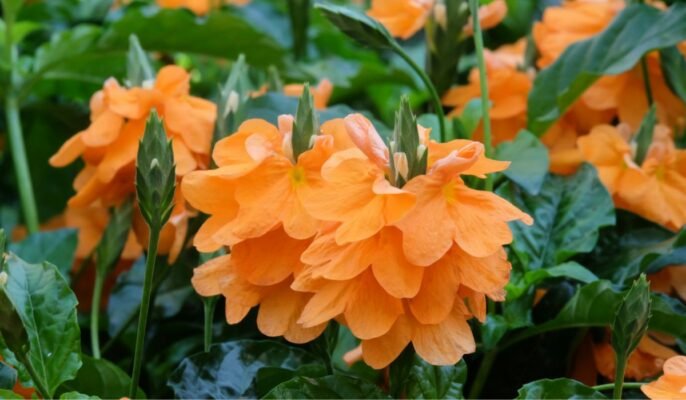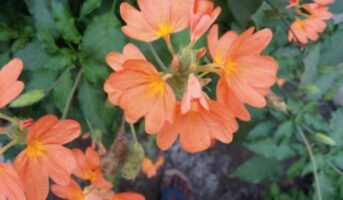The brilliant blooms and waxy leaves of Crossandra, also known as the “firecracker flower,” add a burst of vibrant colour to any garden or indoor space. Native to Sri Lanka and southern India, this plant thrives in tropical and humid conditions but can also be successfully grown as an annual in North American climates. With narrow oblong leaves and eye-catching peach or coral flowers, Crossandra is the perfect addition to a pollinator garden, where it can continuously attract butterflies and bees all summer long. To ensure optimal growth, plant Crossandra in the spring and provide it with adequate moisture and light.
Source: Pinterest
See also: Snapdragon flower: Know facts, growth and maintenance tips
Crossandra: Key facts
| Botanical name | Crossandra Infundibuliformis |
| Family | Acanthaceae |
| Leaves | Glossy and dark green in colour, with a lanceolate to elliptic shape |
| Flowers | Shades of orange, red, yellow, and pink & 2.5-3.8 cm long and are arranged in spikes or clusters. |
| Size | From small, compact plants to larger shrubs
|
| Habitat | Warm, humid climates, and grow best in well-drained soils with moderate watering |
| Plant size | 30 cm to 1.5 metres |
| Bloom time | Late spring to early fall |
Know about: Snapdragon Flower
Crossandra: Physical description
- Leaves: Crossandra species have glossy, dark green leaves that are usually lanceolate to elliptic in shape. The leaves can range in size from 3-15 cm long and 1-6 cm wide, depending on the species.
- Flowers: The flowers of the Crossandra species are the defining feature of the plant. They are brightly coloured, ranging in shades of orange, red, yellow, and pink, and are typically 2.5-3.8 cm long. The flowers are arranged in spikes or clusters and last for several weeks.
- Stem: The stems of Crossandra species are typically green or purplish and are usually quite thin.
- Roots: Crossandra species have fibrous root systems that help the plant absorb moisture and nutrients from the soil.
Source: Pinterest
Types of Crossandra
- Crossandra Infundibuliformis ‘Mona Wallhead’: This tropical plant has salmon-pink flowers and can grow up to a height of 12 to 18 inches when mature. It is cold-hardy and can tolerate temperatures as low as 32 F.
- Crossandra Infundibuliformis ‘Lutea’: Also known as ‘yellow crossandra’, this plant has golden flowers and does well in containers. It blooms from spring until the first frost.
- Crossandra Infundibuliformis ‘Orange Marmalade’: This cultivar has excellent disease and pest resistance and consistently produces bright orange flowers throughout the season. When used as a houseplant, it is known to bloom year-round.
Crossandra: How to grow?
Crossandra is a tropical plant that is easy to grow and can be a great addition to any garden or indoor plant collection. Here are some tips for growing Crossandra:
- Propagation: By taking stem cuttings in the spring or summer, Crossandra plants can be easily multiplied. Just cut off a part of the stem that is 10 cm long, remove the lowest leaves, and plant the stem in a container with moist potting soil.
- Sunlight: Crossandra plants prefer bright, indirect light but can tolerate some shade. If grown indoors, place the plant near a window that receives plenty of light but not direct sunlight.
- Water: Crossandra plants prefer evenly moist soil but do not like to be waterlogged. Water the plant when the top inch of soil feels dry to the touch but avoid letting the soil dry out completely.
- Soil: Crossandra plants prefer well-draining soil that is rich in organic matter. Use a potting mix formulated for tropical plants, or mix equal parts peat moss, perlite, and sand.
- Temperature: Crossandra plants prefer warm temperatures, with a minimum temperature of 60°F (16°C). They are not frost-tolerant, so take care to protect them from cold temperatures.
Crossandra: Care tips
Here are some maintenance tips for Crossandra:
- Humidity: Crossandra plants prefer high humidity, so mist the leaves regularly or place a humidifier near the plant.
- Fertiliser: Crossandra plants benefit from regular fertilisation. Use a balanced fertiliser every 2-4 weeks during the growing season and reduce the frequency in the winter.
- Pruning: Crossandra plants can become leggy over time, so it’s a good idea to prune them regularly to encourage bushier growth. Prune the plant back by about one-third after it has finished blooming to encourage new growth.
- Pest control: Crossandra plants are relatively resistant to pests but can be affected by common indoor plant pests like spider mites and mealybugs. Check your plant regularly for signs of pests and treat promptly if necessary.
- Repotting: Crossandra plants can become pot-bound over time, so it’s a good idea to repot them every 2-3 years. Choose a pot that is one size larger than the current pot, and use a well-draining potting mix.
How to get Crossandra flowers to bloom?
To encourage blooming throughout the summer, there are a few conditions that Crossandra needs to thrive. It’s important to provide ample sunlight during the day in a shady area that doesn’t get too hot. If the plant is in severe low light conditions, it can stop producing flowers. Allow the soil to dry out slightly before watering, as this can help stimulate new blooms. Deadheading is also helpful in initiating new buds and flowers, so be sure to tidy your plant throughout the growing season for optimal results.
Source: Pinterest
Crossandra: Uses
Crossandra is a versatile plant that can be used in a variety of ways.
- Ornamental plant: Crossandra plants are prized for their showy, brightly-coloured flowers that bloom for several weeks each year. They are often grown as indoor or outdoor ornamentals and can be used in beds, borders, or as specimen plants in pots or containers.
- Cut flowers: Crossandra flowers are long-lasting and make excellent cut flowers. They can be used to add colour to floral arrangements or as a stand-alone cut flower in a vase.
- Landscaping: Crossandra plants are well-suited to tropical landscapes and can be used to create an exotic, tropical look in your garden. They are also a great choice for shady areas where other plants may struggle.
- Medicinal uses: Crossandra plants have been used in several traditional medical systems to cure a variety of illnesses, such as headaches, fevers, and skin disorders. More research is required because there is not enough scientific evidence to support these usages.
- Natural insecticide: The sap of Crossandra plants has insecticidal properties and can be used as a natural pest control measure. Simply crush the leaves or stems of the plant and apply the sap to the affected area.
Source: Pinterest
Crossandra: Toxicity
Crossandra plants are generally considered to be non-toxic to humans and pets. They do not contain any known toxins that are harmful to humans or animals. However, as with any plant, it is always a good idea to keep Crossandra plants out of reach of small children and pets, as ingesting any type of plant material can cause digestive issues. Additionally, some individuals may be sensitive to the sap of Crossandra plants and may experience skin irritation or other allergic reactions, so it’s always a good idea to use caution when handling the plant or its sap.
FAQs
What is the botanical name of Crossandra?
The botanical name of Crossandra is Crossandra Infundibuliformis.
Is Crossandra toxic?
No, Crossandra is generally considered to be non-toxic to humans and pets.
What are some uses for Crossandra?
Crossandra can be used as an ornamental plant, cut flower, landscaping plant, natural insecticide, and in traditional medicine.
How do I care for Crossandra?
Crossandra plants prefer bright, indirect light, moist but well-draining soil, and regular watering. Pruning, repotting, and pest control may also be necessary for proper care.
| Got any questions or point of view on our article? We would love to hear from you.
Write to our Editor-in-Chief Jhumur Ghosh at jhumur.ghosh1@housing.com |
Housing News Desk is the news desk of leading online real estate portal, Housing.com. Housing News Desk focuses on a variety of topics such as real estate laws, taxes, current news, property trends, home loans, rentals, décor, green homes, home improvement, etc. The main objective of the news desk, is to cover the real estate sector from the perspective of providing information that is useful to the end-user.
Facebook: https://www.facebook.com/housing.com/
Twitter: https://twitter.com/Housing
Email: editor@housing.com

